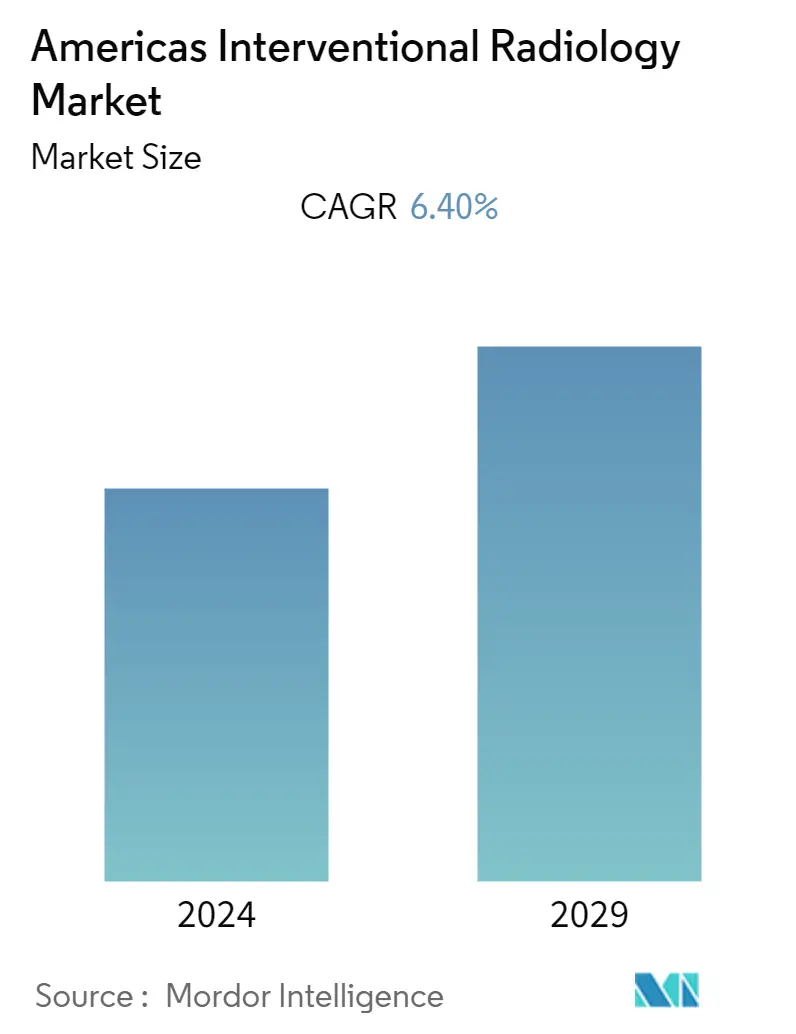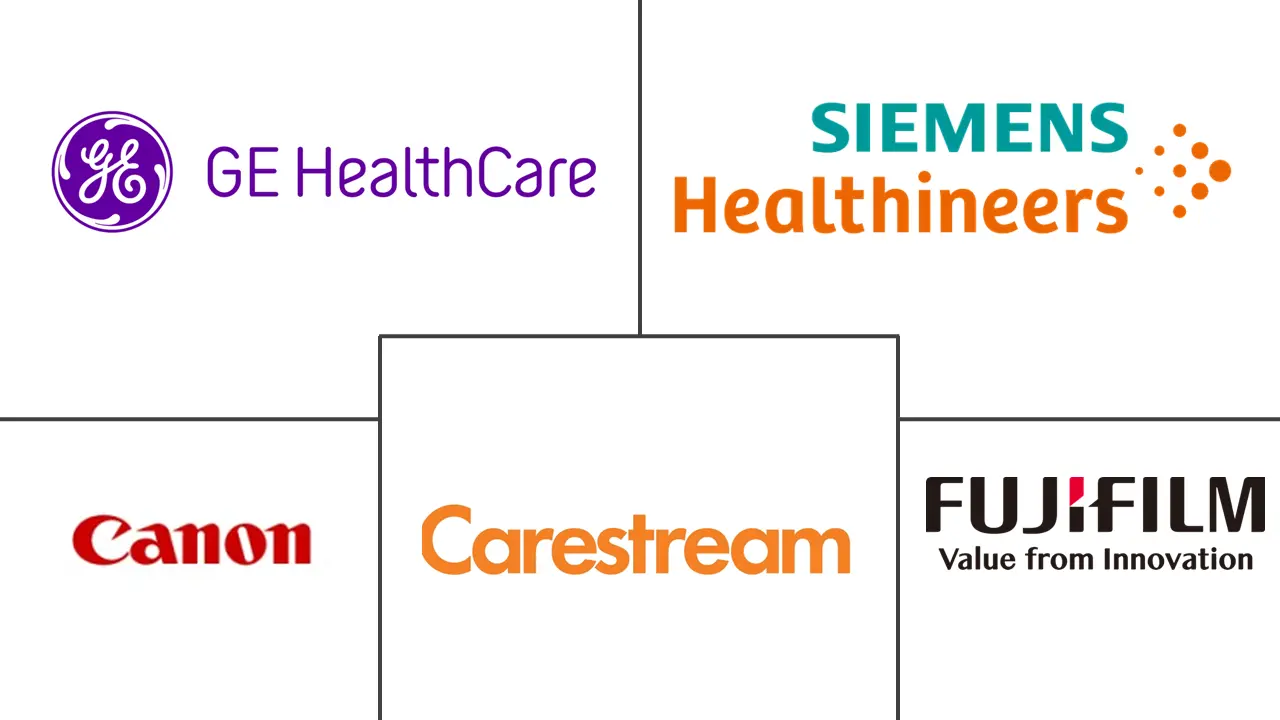Market Size of Americas Interventional Radiology Industry

| Study Period | 2019 - 2029 |
| Base Year For Estimation | 2023 |
| Forecast Data Period | 2024 - 2029 |
| Historical Data Period | 2019 - 2022 |
| CAGR | 6.40 % |
| Market Concentration | Medium |
Major Players
*Disclaimer: Major Players sorted in no particular order |
Americas Interventional Radiology Market Analysis
The Americas interventional radiology market is expected to register a CAGR of 6.4% over the forecast period.
During the pandemic's peak, many healthcare facilities were overwhelmed with COVID-19 patients, which postponed elective and non-urgent procedures, including specific interventional radiology procedures. This disruption in scheduling affected the revenue and patient volumes for interventional radiology practices. For instance, many healthcare departments in the United States temporarily postponed all non-emergency imaging examinations and interventions during the early phase of the pandemic. Furthermore, CT scans of the chest were widely used to aid in diagnosing COVID-19 pneumonia in the Americas region. The characteristic features of COVID-19 pneumonia, such as ground-glass opacities and lung consolidations, were detected and assessed through CT scans, helping physicians identify and triage patients with suspected or confirmed COVID-19. Therefore, looking at the overall scenario, the pandemic significantly impacted the interventional radiology sector in countries like the United States and Canada due to the temporary postponement of radiology practices. However, as the pandemic improved and vaccination efforts increased, there was a resurgence in demand for interventional radiology procedures, especially for patients who had postponed treatments during the pandemic's peak.
The major factors driving the growth of America's interventional radiology market include the increasing burden of chronic diseases and technological advancements in interventional radiology devices. The rising incidence of chronic diseases such as cardiovascular diseases, cancer, and neurological disorders in the Americas has led to a higher demand for interventional radiology techniques, which are often minimally invasive and require shorter recovery times than traditional surgical methods, driving its market in the region. For instance, according to the data published by the CDC in May 2023, every 40 seconds, someone suffers from a heart attack in the United States. According to the same source, approximately 805,000 people in the United States suffer heart attacks yearly. In addition, according to the data published by the NIH in March 2022, about half of Americans between ages 45 and 84 suffer from atherosclerosis. Therefore, the large number of people suffering from heart attacks and atherosclerosis in the region is projected to drive the demand for angiography systems to identify blockages, narrowing, or abnormalities in blood vessels.
Interventional radiology involves the imaging technologies such as real-time X-rays, ultrasound, CT, or MRI to perform interventional procedures directly at the cancer site, focusing now on tumors or their blood supplies. Also, interventional radiology procedures are often considered an alternative to surgery, providing minimal recovery times and a low risk of complications. Thus, as the number of people diagnosed with cancer increases, there will be a corresponding rise in the demand for these imaging modalities to detect and stage cancer at its earliest and most treatable stages. For instance, according to the data released by the European Society for Medical Oncology in June 2022, an estimated 1.5 million new cancer cases are recorded annually in Latin America and the Caribbean, with an incidence rate of 186.5 per 100,000 population. In addition, according to the article published in the Journal of Biomedical Research & Environmental Sciences in April 2023, it has been observed that lung cancer was the third most common tumor in men and the fourth in women in Brazil in 2022. Also, about 18,020 new lung cancer cases in men were reported in Brazil in 2022, representing 7.5% of all cancers. As per the source mentioned above, about 14,540 new lung cancer cases were reported in women in Brazil, which represented 6.0% of all cancers. Brazil is anticipated to experience an 88% rise in new lung cancer cases between 2023 and 2025. Therefore, the high prevalence of cancer in the region is projected to drive the demand for interventional radiology procedures such as Transarterial Chemoembolization (TACE) to deliver chemotherapy drugs directly to the tumor, Radiofrequency Ablation (RFA), which uses heat to destroy tumors, and Microwave Ablation (MWA), which uses microwaves to ablate tumors.
Furthermore, the active participation of public organizations in the region in developing international radiology suites integrated with advanced technologies developed by prominent players is also projected to drive market growth during the forecast period. For instance, in April 2022, Oak Valley Health Organization opened one of Canada's first interventional radiology suites, incorporated with innovative GE healthcare technology, the Allia IGS 7 system for diagnosing and treating complex diseases. This system is integrated with a laser-guided mobile robotic gantry, which enables patients to be precisely positioned for minimally invasive techniques and is ergonomic and easy to use. Therefore, such advancements will likely attract attention and interest from healthcare providers in America, driving them to upgrade their facilities and invest in similar advanced systems to offer superior patient care, thereby causing the market growth.
Therefore, the rising number of various chronic diseases and active adoption of advanced interventional radiology technologies in the region is projected to drive market growth during the forecast period. However, the risk of high radiation exposure and high cost of equipment is projected to hinder market growth during the study period.
Americas Interventional Radiology Industry Segmentation
As per the scope of the report, interventional radiology is a medical specialty that employs minimally invasive procedures guided by medical imaging technologies to diagnose, treat, and manage a wide range of medical conditions. It involves the use of small instruments, catheters, and needles to access specific areas of the body, often through small incisions or natural body openings, thus reducing the need for traditional open surgery. By utilizing advanced imaging techniques like X-rays, fluoroscopy, ultrasound, CT scans, or MRI, interventional radiologists can visualize internal structures and blood vessels to perform precise and targeted interventions. The Americas Interventional Radiology Market is Segmented by Product (MRI Systems, Ultrasound Imaging Systems, CT Scanners, Angiography Systems, Fluoroscopy Systems, Biopsy Devices, and Other Products), Application (Cardiology, Urology and Nephrology, Oncology, Gastroenterology, and Other Applications), and Geography (North America and South America). The report offers the value (in USD million) for the above segments.
| By Product | |
| MRI Systems | |
| Ultrasound Imaging Systems | |
| CT Scanners | |
| Angiography Systems | |
| Fluoroscopy Systems | |
| Biopsy Devices | |
| Other Products |
| By Application | |
| Cardiology | |
| Urology and Nephrology | |
| Oncology | |
| Gastroenterology | |
| Other Applications |
| Geography | |||||
| |||||
|
Americas Interventional Radiology Market Size Summary
The Americas interventional radiology market is poised for significant growth, driven by the increasing prevalence of chronic diseases and advancements in radiology technologies. The market experienced disruptions during the COVID-19 pandemic, with many non-urgent procedures postponed, impacting revenue and patient volumes. However, as the situation improved, there was a resurgence in demand for interventional radiology procedures, particularly for patients who had delayed treatments. The rising incidence of chronic conditions such as cardiovascular diseases, cancer, and neurological disorders has heightened the demand for minimally invasive interventional radiology techniques, which offer shorter recovery times compared to traditional surgeries. This trend is further supported by the integration of advanced imaging technologies in interventional procedures, enhancing diagnostic and therapeutic capabilities.
The market's growth is also fueled by the active participation of public organizations and the introduction of advanced interventional radiology suites equipped with cutting-edge technologies. The high prevalence of cancer in the region, coupled with the increasing number of product launches, is expected to drive the demand for interventional radiology procedures. The presence of a substantial number of interventional radiologists in North America, particularly in the United States, contributes to the increased availability of these specialized services, further propelling market expansion. Despite challenges such as high radiation exposure and equipment costs, the Americas interventional radiology market is set to grow, supported by the ongoing advancements in medical imaging and the rising need for effective disease management solutions.
Americas Interventional Radiology Market Size - Table of Contents
-
1. MARKET DYNAMICS
-
1.1 Market Overview
-
1.2 Market Drivers
-
1.2.1 Increasing Burden of Chronic Diseases
-
1.2.2 Technological Advancements in Interventional Radiology Devices
-
-
1.3 Market Restraints
-
1.3.1 Risk of High Radiation Exposure
-
1.3.2 High Cost of Equipment
-
-
1.4 Porter's Five Forces Analysis
-
1.4.1 Threat of New Entrants
-
1.4.2 Bargaining Power of Buyers/Consumers
-
1.4.3 Bargaining Power of Suppliers
-
1.4.4 Threat of Substitute Products
-
1.4.5 Intensity of Competitive Rivalry
-
-
-
2. MARKET SEGMENTATION (Market Size by Value-USD million)
-
2.1 By Product
-
2.1.1 MRI Systems
-
2.1.2 Ultrasound Imaging Systems
-
2.1.3 CT Scanners
-
2.1.4 Angiography Systems
-
2.1.5 Fluoroscopy Systems
-
2.1.6 Biopsy Devices
-
2.1.7 Other Products
-
-
2.2 By Application
-
2.2.1 Cardiology
-
2.2.2 Urology and Nephrology
-
2.2.3 Oncology
-
2.2.4 Gastroenterology
-
2.2.5 Other Applications
-
-
2.3 Geography
-
2.3.1 North America
-
2.3.1.1 United States
-
2.3.1.2 Canada
-
2.3.1.3 Mexico
-
-
2.3.2 South America
-
2.3.2.1 Brazil
-
2.3.2.2 Argentina
-
2.3.2.3 Rest of South America
-
-
-
Americas Interventional Radiology Market Size FAQs
What is the current Americas Interventional Radiology Market size?
The Americas Interventional Radiology Market is projected to register a CAGR of 6.40% during the forecast period (2024-2029)
Who are the key players in Americas Interventional Radiology Market?
Carestream Health, GE Healthcare, Siemens Healthineers AG, Canon Medical Systems Corporation and FUJIFILM Holdings Corporation are the major companies operating in the Americas Interventional Radiology Market.

